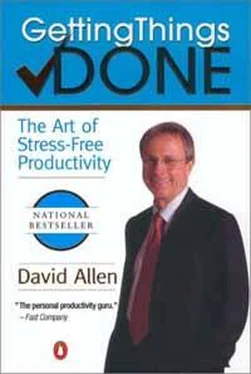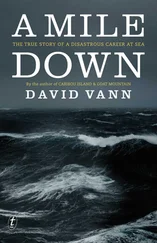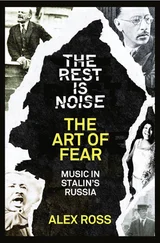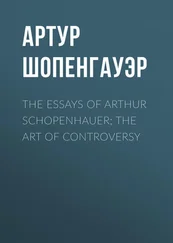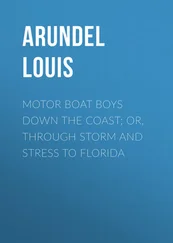The Danger of "Hold and Review" Files and Piles
Many people have created some sort of "Hold and Review" pile or file (or whole drawer) that vaguely fits within the category of "Someday/Maybe." They tell themselves, "When I have time, I may like to get to this," and a "Hold and Review" file seems a convenient place to put it. I personally don't recommend this particular kind of subsystem, because in virtually every case I have come across, the client "held" but didn't "review," and there was numbness and resistance about the stack. The value of "someday/ maybe" disappears if you don't put your conscious awareness back on it with some consistency.
Also, there's a big difference between something that's man-aged well, as a "Someday/Maybe" list, and something that's just a catchall bucket for "stuff." Usually much of that stuff needs to be tossed, some of it needs to go into "Read/Review," some needs to be filed as reference, some belongs on the calendar or in a tickler file (see page 173) for review in a month or perhaps at the beginning of the next quarter, and some actually has next actions on it. Many times, after appropriately processing someone's "Hold and Review" drawer or file, I've discovered there was nothing left in it!
Using the Calendar for Future Options
Your calendar can be a very handy place to park reminders of things you might want to consider doing in the future. Most of the people I've coached were not nearly as comfortable with their calendars as they could have been; otherwise they probably would have found many more things to put in there.
One of the three uses of a calendar is for day-specific information. This category can include a number of things, but one of the most creative ways to utilize this function is to enter things that you want to take off your mind and reassess at some later date. Here are a few of the myriad things you should consider inserting:
• Triggers for activating projects
• Events you might want to participate in
• Decision catalysts
Triggers for Activating Projects If you have a project that you don't really need to think about now but that deserves a flag at some point in the future, you can pick an appropriate date and put a reminder about the project in your calendar for that day. It should go in some day-specific (versus time-specific) calendar slot for the things you want to be reminded of on that day; then when the day arrives, you see the reminder and insert the item as an active project on your "Projects" list. Typical candidates for this treatment are:
• Special events with a certain lead time for handling (product launches, fund-raising drives, etc.)
• Regular events that you need to prepare for, such as budget reviews, annual conferences, planning events, or meetings (e.g.,when should you add next year's "annual sales conference" to your "Projects" list?)
• Key dates for significant people that you might want to do some-thing about (birthdays, anniversaries, holiday gift-giving, etc.)
Events You Might Want to Participate In
You probably get notices constantly about seminars, conferences, speeches, and social and cultural events that you may want to decide about attending as the time gets closer. So figure out when that "closer" time is and put a trigger in your calendar on the appropriate date—for example:
"Chamber of Commerce breakfast tomorrow?"
"Tigers season tickets go on sale today"
"PBS special on Australia tonight 8:00 P.M."
"Church BBQ next Saturday"
If you can think of any jogs like these that you'd like to put into your system, do it right now.
Decision Catalysts Once in a while there may be a significant decision that you need to make but can't (or don't want to) make right away. That's fine, as long as you've concluded that the additional information you need has to come from an internal rather than an external source (e.g., you need to sleep on it).
(Obviously, external data you need in order to make a decision should go on your "Next Actions" or "Waiting For" lists.) But in order to move to a level of OK-ness about not deciding, you'd better put out a safety net that you can trust to get you to focus on the issue appropriately in the future. A calendar reminder can serve that purpose. [11] If you're using a group-accessible calendar, you must maintain discretion about these kinds of triggers. Digital calendars usually have "private" categorization functions you can use for entries you don't necessarily want everyone to see.
It's OK to decide not to decide—as long as you have a decide-not-to-decide system
Some typical decision areas in this category include:
• Hire/fire
• Merge/acquire/sell/divest
• Change job/career
This is a big topic to devote so little space to, I know, but go ahead and ask yourself, "Is there any major decision for which I should create a future trigger, so I can feel comfortable just 'hanging out' with it for now?" If there is, put some reminder in your calendar to revisit the issue.
The "Tickler" File
One elegant way to manage nonactionable items that may need an action in the future is the "tickler" file. [12] Also referred to as a "suspense," "bring forward," or "follow-up" file.
A three-dimensional version of a calendar, it allows you to hold physical reminders of things that you want to see or remember—not now, but in the future. It can be an extremely functional tool, allowing you to in effect set up your own post office and "mail" things to yourself for receipt on a designated future date. I myself have used a tickler file for years and can't imagine being without it.
Essentially the tickler is a simple file-folder system that allows you to distribute paper and other physical reminders in such a way that whatever you want to see on a particular date in the future "automatically" shows up that day in your in-basket.
If you have a secretary or assistant, you can entrust at least a part of this task to him or her, assuming that he/she has some working version of this or a similar system. Typical examples would be:
• "Hand me this agenda the morning of the day I have the meeting."
• "Give this back to me on Monday to rethink, since it applies to a meeting on Wednesday."
• "Remind me about the Hong Kong trip two weeks ahead, and we'll plan the logistics."
Then every day of the week, that day's folder is pulled and reviewed.
While you can (and probably should) utilize staff to handle as much of this as is appropriate, I recommend that, if you can integrate it into your life-style, you maintain your own tickler file. There are many useful functions it can perform, at least some of which you may want to avail yourself of outside the pale of your assistant's responsibilities. I use my tickler file to manage my travel tickets and confirmations; paper-based travel directions, agendas, and maps; reminders of event notifications that come in the mail; information about "might-want-to-buy" kinds of things I want to reconsider in the future; and so forth.
Bottom line: the tickler file demands only a one-second-per-day new behavior to make it work, and it has a payoff value logarithmically greater than the personal investment.
Setting Up a Tickler File You need forty-three folders — thirty-one daily files labeled "1" through "31," and twelve more labeled with the names of the months of the year. The daily files are kept in front, beginning with the file for tomorrow's date (if today is October 5, then the first file would be "6"). The succeeding daily files represent the days of the rest of the month ("6" through "31"). Behind the "31" file is the monthly file for the next month ("November"), and behind that are the daily files "1" though "5." Following that are the rest of the monthly files ("December" through "October"). The next daily file is emptied into your in-basket every day, and then the folder is refiled at the back of the dailies (at which point, instead of October 6, it represents November 6). In the same way, when the next monthly file reaches the front (on October 31 after you empty the daily file, the "November" file will be the next one, with the daily files "1" through "31" behind it), it's emptied into the in-basket and refiled at the back of the monthlies to represent November a year from now. This is a "perpetual" file, meaning that at any given time it contains files for the next thirty-one days and the next twelve months.
Читать дальше
